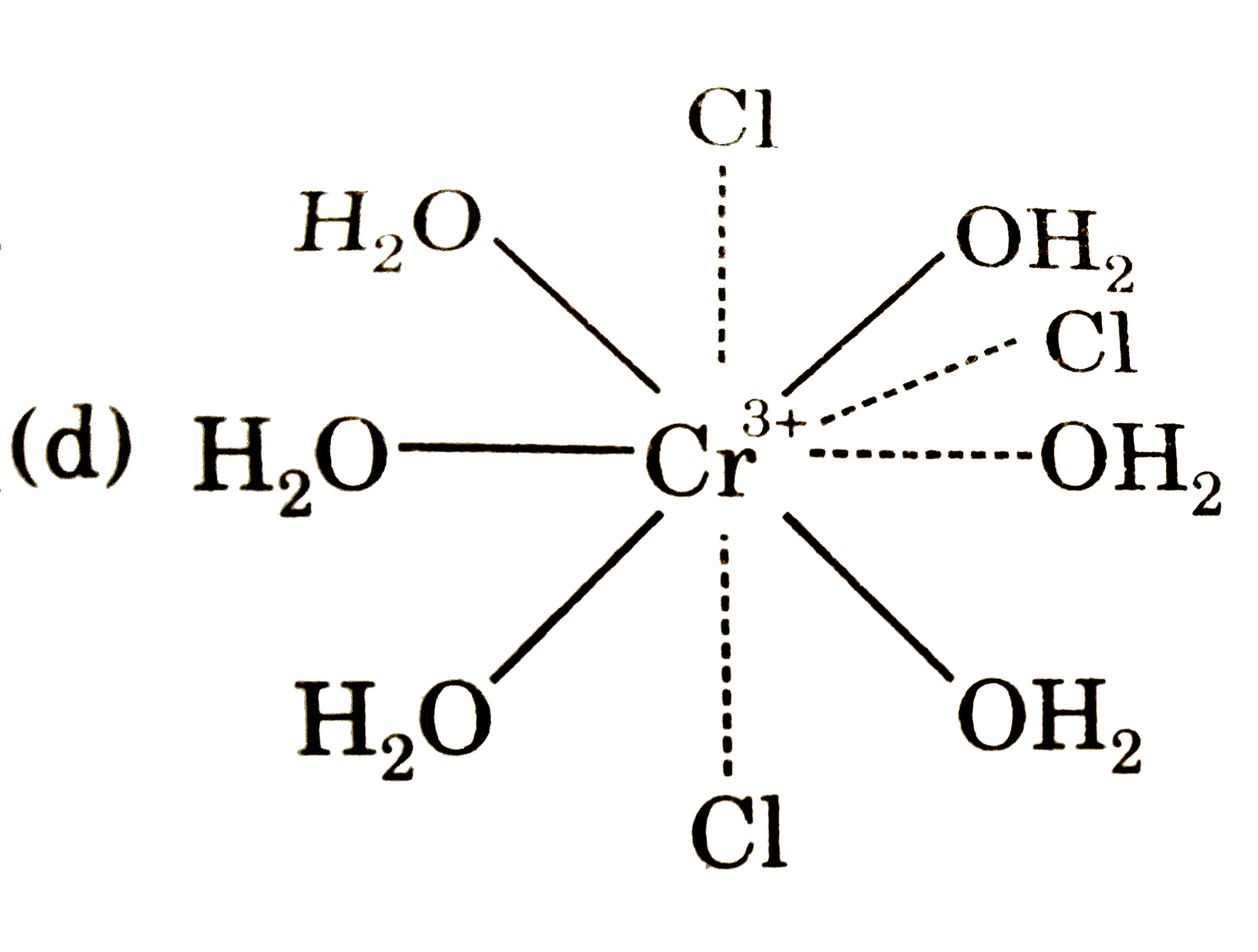A, B and C are three complexes of chromium (III) with the empirical formula H12O6Cl3Cr. All the three complexes have water and chloride ion as ligands. Complex A does not react with concentrated H2SO4, whereas complexes B and C lose 6.75% and 13.5% of their original weight, respectively, on treatment with concentrated H2SO4.
According to the Werner theory, the structure of complex A is represented by :




The correct Answer is:D
A⇒[Cr(H2O)6]Cl3
Topper's Solved these Questions
- COORDINATION COMPOUNDSBOOK - GRB PUBLICATIONCHAPTER - COORDINATION COMPOUNDSEXERCISE - COMPREHENSION 6
2 Videos
- COORDINATION COMPOUNDSBOOK - GRB PUBLICATIONCHAPTER - COORDINATION COMPOUNDSEXERCISE - COMPREHENSION 7
2 Videos
- COORDINATION COMPOUNDSBOOK - GRB PUBLICATIONCHAPTER - COORDINATION COMPOUNDSEXERCISE - COMPREHENSION 4
3 Videos
- CHEMICAL KINETICSBOOK - GRB PUBLICATIONCHAPTER - CHEMICAL KINETICSEXERCISE - Subjective Type
63 Videos
- D-BLOCK ELEMENTSBOOK - GRB PUBLICATIONCHAPTER - D-BLOCK ELEMENTSEXERCISE - Subjective Type
18 Videos
Similar Questions
A, B and C are three complexes of chromium (III) with the empirical formula H2O6Cl3Cr. All the three complexes have water and chloride ion as ligands.
Complex A does not react with concentrated H2SO4, whereas complexes B and C lose 6.75% and 13.5% of their original mass, respectively, on treatment with concentrated H2SO4. Identify A, B and C
View SolutionA, B and C are three complexes of chromium(III) with empirical formula H12O6CI3Cr. All the three complexes have water and chloride ions as ligands. Complex A does not react with conc. H2SO4, whereas, complexes B and Close 6.7% and 13.5% of their original weight respectively on treatment with concentrated H2SO4. Identity A, B and
View Solution
Knowledge Check
A,B and C are three complexes of chromium(III) with the empirical formula H12O6C13Cr All the three complexes not react with concentrated H2SO4 whereas complexes B and C lose 6.75% and 13.5% of their original mass respectively, on treatment on treatment with conectrated H2SO4 Identify A,B and C .
A[Cr(H2O)4Cl2].2H2OB[Cr(H2O)5Cl]Cl2.H2OC[Cr(H2O)3Cl3].3H2OD[Cr(H2O)6]Cl3A,B and C are three complexes of chromium(III) with the empirical formula H12O6C13Cr All the three complexes not react with concentrated H2SO4 whereas complexes B and C lose 6.75% and 13.5% of their original mass respectively, on treatment on treatment with conectrated H2SO4 Identify A,B and C .
A[Cr(H2O)4Cl2]Cl.2H2OB[Cr(H2O)3Cl3].3H2OC[Cr(H2O)5Cl]Cl2.H2OD[Cr(H2O)6]Cl3A, B and C are three complexes of chromium (III) with the empirical formula H12O6Cl3Cr. All the three complexes have water and chloride ion as ligands. Complex A does not react with concentrated H2SO4, whereas complexes B and C lose 6.75% and 13.5% of their original weight, respectively, on treatment with concentrated H2SO4.
According to the Werner theory, the structure of complex A is represented by :A[Cr(H2O)4(H)4(O)2]Cl3B[Cr(H2O5)5(H)2(O)]Cl3C[Cr(H2O)6]Cl3D[Cr(H2O)5Cl]Cl2.H2O
A, B and C are three complexes of chromium(III) with empirical formula H12O6CI3Cr. All the three complexes have water and chloride ions as ligands. Complex A does not react with conc. H2SO4, whereas, complexes B and Close 6.7% and 13.5% of their original weight respectively on treatment with concentrated H2SO4. Identity A, B and
View SolutionA, B and C are three complexes of chromium (III) with the empirical formula H12O6Cl3Cr. All the three complexes have water and chloride ion as ligands. Complex A does not react with concentrated H2SO4, whereas complexes B and C lose 6.75% and 13.5% of their original weight, respectively, on treatment with concentrated H2SO4.
Complexes A, B and C are not distinguished by:
View SolutionA, B and C are three complexes of chromium (III) with the empirical formula H12O6Cl3Cr. All the three complexes have water and chloride ion as ligands. Complex A does not react with concentrated H2SO4, whereas complexes B and C lose 6.75% and 13.5% of their original weight, respectively, on treatment with concentrated H2SO4.
Complexes A, B and C are not distinguished by:
View SolutionA, B and C are three complexes of chromium (III) with the empirical formula H12O6Cl3Cr. All the three complexes have water and chloride ion as ligands. Complex A does not react with concentrated H2SO4, whereas complexes B and C lose 6.75% and 13.5% of their original weight, respectively, on treatment with concentrated H2SO4.
Which type of isomerism is possible in complex C?
View SolutionA, B and C are three complexes of chromium (III) with the empirical formula H12O6Cl3Cr. All the three complexes have water and chloride ion as ligands. Complex A does not react with concentrated H2SO4, whereas complexes B and C lose 6.75% and 13.5% of their original weight, respectively, on treatment with concentrated H2SO4.
Which type of isomerism is possible in complex C?
View Solution